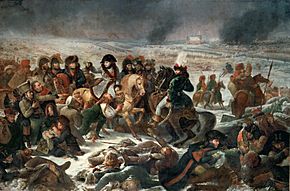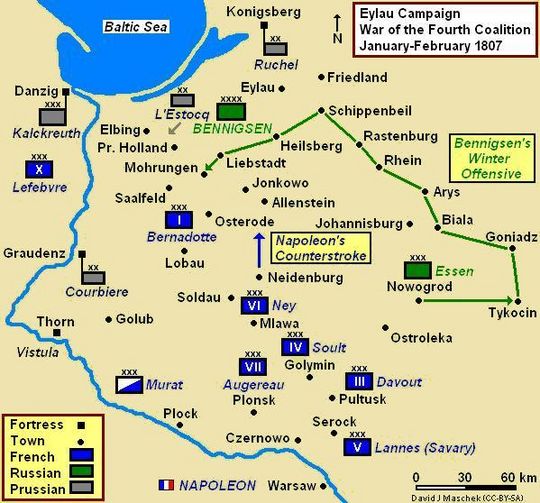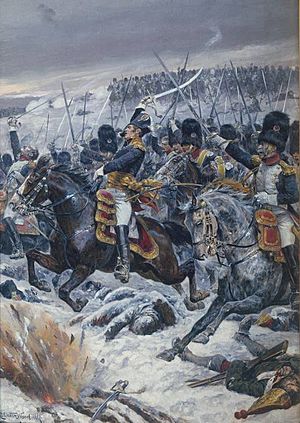Battle of Eylau facts for kids
Quick facts for kids Battle of Eylau |
|||||||
|---|---|---|---|---|---|---|---|
| Part of the War of the Fourth Coalition | |||||||
 Napoléon on the Battlefield of Eylau by Antoine-Jean Gros |
|||||||
|
|||||||
| Belligerents | |||||||
| Commanders and leaders | |||||||
| Strength | |||||||
| 75,000: Napoleon: 45,000 Ney: 14,500 Davout: 15,000 300 guns |
76,000-83,000: 400 guns |
||||||
| Casualties and losses | |||||||
| 15,000–29,643 | 15,000–26,000 | ||||||
The Battle of Eylau was a very tough and bloody fight that happened on February 7 and 8, 1807. It was fought between Napoleon's French army, called the Grande Armée, and the Imperial Russian Army. The Russian army was led by Levin August von Bennigsen. The battle took place near a town called Preussisch Eylau in East Prussia.
During the battle, the Russians got help from a Prussian army group led by Anton Wilhelm von L'Estocq. After 1945, the town of Preussisch Eylau was renamed Bagrationovsk. This battle was part of the War of the Fourth Coalition, which was a bigger conflict in the Napoleonic Wars.
Napoleon's armies had won big victories before this battle. They defeated the army of the Austrian Empire in 1805. They also crushed the combined Austrian and Russian armies at the Battle of Austerlitz. In 1806, Napoleon defeated the armies of the Kingdom of Prussia at the Battle of Jena–Auerstedt. He then chased down the remaining Prussian forces across many towns.
In early 1807, the Russian army, led by Bennigsen, attacked in East Prussia. Napoleon quickly responded with his own attack. He wanted to stop the Russians from retreating. However, Cossacks (Russian soldiers) captured Napoleon's battle plans. This allowed Bennigsen to quickly pull his army back. The French chased them for several days. Finally, they found the Russians ready for a fight at Eylau.
On the first day, there was a fierce fight in the evening. The French took the village of Eylau, but both sides lost many soldiers. The next day was even more intense. Napoleon's first attack failed, causing huge losses for his army. To turn things around, he ordered a massive cavalry charge. This gave the French time for their right side to join the fight. The Russian left side was pushed back, and Bennigsen's army was almost defeated.
Just in time, a Prussian army group arrived and helped the Russians. They pushed back the French right side. As night fell, another French army group finally arrived on the French left. That night, Bennigsen decided to retreat. This left Napoleon in control of a snowy battlefield covered with thousands of dead and wounded soldiers.
Eylau was the first time Napoleon's Grande Armée faced such a tough challenge. The idea that Napoleon was unbeatable was shaken. However, the French eventually won the war. Czar Alexander I decided to make peace with France after Russia lost the Battle of Friedland.
Contents
Why Did the Battle Happen?
After defeating the Prussian army, Napoleon moved his forces east. He was chasing the remaining enemy troops, mostly Russians. The Russian commander, Mikhail Kamensky, kept retreating. This allowed the French army to enter Poland easily.
As the French moved east, they met Russian resistance at the Wkra River. The French crossed the river on December 23 at the Battle of Czarnowo. The fighting became tougher, and on December 26, both armies fought hard at the Battles of Pułtusk and Gołymin. After these battles, Napoleon's troops rested in Poland for the winter.
The Russian Attack and French Response
In January 1807, the new Russian commander, Levin August von Bennigsen, tried to surprise the French. He moved most of his army north into East Prussia. His army, including a Prussian group, first met Marshal Michel Ney's French troops. Ney had moved far north, against Napoleon's orders.
After pushing Ney's troops aside, the Russians attacked Marshal Jean-Baptiste Bernadotte's isolated French army group. Hard fighting at the Battle of Mohrungen allowed Bernadotte's group to escape. Napoleon saw a chance to turn the situation around. He told Bernadotte to retreat and ordered the rest of his army to move north. This plan was meant to surround the Russian army and cut off their escape route.
A Lucky Break for the Russians
By chance, some Cossacks captured a messenger carrying Napoleon's plans to Bernadotte. They quickly sent this information to General Pyotr Bagration. Bernadotte never got the message. But Bennigsen knew about the trap and immediately ordered his army to retreat east. He wanted to avoid being surrounded.
As Bennigsen quickly gathered his army, parts of Marshal Nicolas Soult's French army reached his left side. On February 3, French General Jean François Leval fought with Russian Lieutenant-General Nikolay Kamensky's division. The French took a village and bridge, but the Russians briefly took the bridge back. The French ended up holding the area.
Bennigsen retreated north and then northeast. By early February, the Russian army was fully retreating, with the French close behind. After trying to stand and fight a few times, Bennigsen decided to make a final stand at Preussisch-Eylau. Napoleon's army was spread out due to bad roads and winter weather. Bennigsen's forces, however, were already together.
The Battle Begins: Day One
Marshal Jean-de-Dieu Soult's French army and Marshal Joachim Murat's cavalry were the first French groups to reach the area near Eylau. This was around 2:00 PM on February 7. The Russian rearguard, led by Pyotr Bagration, was positioned on a plateau in front of Eylau. The French attacked but were pushed back. Bagration's job was to fight hard to give the main Russian army time to move its heavy cannons through Eylau.
Later that afternoon, the French got more soldiers. Marshal Pierre Augereau's army and the Imperial Guard arrived. This gave Napoleon about 45,000 soldiers. With so many French forces, Bagration slowly pulled his troops back. Another group, led by Michael Andreas Barclay de Tolly, covered their retreat in the town of Eylau.
Fighting for the Town
The fighting continued as French forces attacked Barclay's troops in Eylau. Historians disagree on why this happened. Napoleon later said he ordered the attack to trap the Russians and give his soldiers shelter from the cold. However, other evidence suggests the attack was unplanned. It might have started as a small fight that the French marshals failed to stop. Soldiers might have also attacked on their own to find shelter from the freezing night.
Regardless of how it started, the fight for the town quickly grew into a large and bitter battle. It continued long after dark. Both sides lost about 4,000 soldiers. Barclay was shot in the arm and had to leave. At 10:00 PM, Bennigsen ordered the Russians to retreat a short distance, leaving the town to the French. He later claimed he did this to trick the French into attacking his center the next day.
Even though the French took the town, most of them, like all the Russians, spent the night outside in the cold. Neither side had much food. The Russians were disorganized, and the French had problems with roads and weather. During the night, Bennigsen moved some of his troops to strengthen his reserve. This made his right side shorter.
The Main Battle: Day Two
At the start of the second day, Bennigsen had 67,000 Russian troops and 400 cannons ready. The French had fewer, with 49,000 troops and 300 cannons. The Russians expected 9,000 Prussians under Anton Wilhelm von L'Estocq to arrive. The French expected Marshal Louis Nicolas Davout's 15,000 troops and Marshal Michel Ney's 14,000 troops. Bernadotte's army was too far away to help.
Dawn brought light but no warmth. Heavy snowstorms continued all day, making it hard to see. The two armies were on parallel ridges. The French started by testing the Russian positions, especially on the Russian right. Bennigsen, worried the French would find his shortened right side, began the battle by firing his cannons. The French fired back, and a long artillery duel began. The French had an advantage because their cannons were more spread out.
Napoleon's Plan and a Blizzard
The cannon fire made Napoleon realize the Russians were going to fight. He quickly sent messengers to Ney, ordering him to march to Eylau. Meanwhile, the French took some buildings near the Russian right side. Russian soldiers pushed them out. Both sides increased the fighting, with the Russians attacking the French left. Napoleon thought this was a sign of a bigger Russian attack on Eylau. At the same time, Davout's French army began to arrive on the Russian left.
To stop the Russian attack and pin down their army, Napoleon ordered an attack on the Russian center and left. Augereau's army was on the left, and Louis Vincent Le Blond de Saint-Hilaire's division was on the right. Augereau was very sick and had to be helped onto his horse.
Then, a blizzard suddenly hit, making it impossible to see. Augereau's troops lost their way and moved left, away from Saint-Hilaire. Augereau's attack hit the Russian line in the wrong place. They came under fire from their own blinded French cannons, and then from 70 Russian cannons at close range. Augereau's army was in chaos and suffered huge losses. One regiment, the 14th Ligne, fought until the last man, refusing to surrender.
A Close Call for Napoleon
Meanwhile, Saint-Hilaire's division, moving alone in the correct direction, could not do much against the Russian left. Bennigsen took advantage of the situation. He attacked Saint-Hilaire's division with more cavalry and brought up his reserve infantry to attack the damaged French center. Augereau and his few thousand survivors fell back to Eylau. There, they were attacked by about 5,000 Russian infantry.
At one point, Napoleon himself, who was using a church tower as his command post, was almost captured. But his personal staff held off the Russians just long enough for some Guard battalions to arrive. The Guard charged with bayonets, and French cavalry attacked the Russian column from behind. The attacking Russian group was almost wiped out. For four hours, the French center was in great danger.
Murat's Great Cavalry Charge
With his center almost broken, Napoleon ordered a massive charge by Murat's 11,000 cavalry soldiers. This was the last large group of fresh troops the French had.
This began one of the biggest cavalry charges in history. Hidden by the snow, Murat's cavalry rode through the Russian infantry around Eylau. They then split into two groups. One group charged into the side of the Russian cavalry, scattering them. Murat himself led the other group, driving the Russian cavalry back onto their infantry.
Fresh Russian cavalry forced Murat to pull back. But another group of French cavalry, called cuirassiers, broke through everything. They cut down the broken Russian soldiers. The cuirassiers then rode through the Russian cannons, chasing away or killing the gunners. They broke through the first line of Russian infantry and then the second. The charge finally stopped in front of the Russian reserves.
A second wave of cavalry then charged the Russians as they tried to regroup. They rode through both lines of infantry. Another group charged into the Russian infantry where Augereau's corps had fought. The cavalry then regrouped and charged back again. They finally pulled back under the protection of the Guard cavalry. Murat lost many trained soldiers, but his charge relieved the pressure on the French. It also stopped the Russians long enough for Davout's army to get into position. French cavalry had rarely played such an important role in a battle.
The Arrival of Prussians and Ney
Davout's army, about 15,000 strong, was now in position. They began to push back the Russian left side. Even though the Russian center was in disarray, Napoleon did not follow up Murat's charge with his Guard. He knew that 9,000 Prussians under L'Estocq were still out there. So, he kept his Guard in reserve.
Throughout the afternoon, Soult, Augereau, and Murat held their ground. Davout, helped by Saint-Hilaire, slowly pushed the Russian left further and further back. By 3:30 PM, it looked like the Russians would break apart.
For several important hours, Bennigsen could not be found. He had ridden to L'Estocq to tell him to hurry his Prussian troops to the battle. His mission worked. L'Estocq's 9,000 Prussian soldiers, having lost some men to Ney's pursuit, arrived. They moved behind the Russian position to its left side. They also gathered Russian soldiers who had fallen behind.
At 4:00 PM, L'Estocq attacked Davout's exposed right side. The encouraged Russians then launched a new attack against Davout. The Russians also got help from 36 cannons. Over the next three hours, Davout was stopped and forced back. As night fell, everyone was exhausted, and the fighting on the Russian left died down.
By then, the sound of cannons on the Russian right announced Ney's arrival. Napoleon had not called Ney until 8:00 AM that day, when he realized the Russians planned to fight. Ney was close to the battle, but the heavy snow muffled the sound of cannons. He did not know what was happening until a messenger reached him around 10:30 AM. Ney's leading division reached the battlefield around 7:00 PM. It immediately attacked the Russian right and rear. Bennigsen fought back, and fierce fighting continued until 10:00 PM. Then, both sides pulled back a little.
After a difficult meeting with his generals, Bennigsen decided to retreat at 11:00 PM. Covered by the Cossacks, the Russians quietly left. The tired French did not even notice until 3:00 AM and were too exhausted to chase them.
What Happened After the Battle?
After 14 hours of non-stop fighting, the only result was a huge loss of life. Experts have different ideas about how many soldiers were lost. Russian casualties are estimated to be between 15,000 and 20,000 killed or wounded. They also lost 3,000 men, 23 cannons, and 16 flags captured. Bennigsen himself said his army lost up to 9,000 dead and 7,000 wounded.
The French lost between 10,000 and 15,000 soldiers. Some estimates say as many as 25,000 to 30,000 French casualties. The French also lost five eagles (their regimental flags). One German historian, Horst Schulz, estimated that the French lost 29,643 men in total. This included 4,893 killed, 23,598 wounded, and 1,152 missing.
The French gained control of the battlefield, which was just a huge area of bloody snow and frozen bodies. But they had suffered enormous losses and failed to destroy the Russian army. The morning after the battle, Marshal Ney rode over the fields of Eylau. He said, Quel massacre! Et sans résultat! which means "What a massacre! And without result!"
The Battle of Eylau was very different from Napoleon's earlier, decisive victories. It stopped the French advance and left both sides exhausted. This only made the war last longer. After the battle, Napoleon sent a general to the King of Prussia. He offered a separate peace deal. This deal would have meant French forces leaving Prussia and restoring its borders. However, Prussia wanted to stay allied with Russia and quickly refused the offer.
The fighting continued until the French won a decisive victory at the Battle of Friedland in June 1807. This forced Czar Alexander I to negotiate for peace. After a meeting between the two emperors, both sides signed the peace Treaties of Tilsit. These treaties were much harder on Prussia than the earlier offer. Prussia lost almost half of its territory.
The main surgeon of Napoleon's army, Baron Dominique-Jean Larrey, treated the wounded. He used the meat of young horses to make soup and a dish called bœuf à la mode. The good results encouraged him to promote eating horse meat in France.











